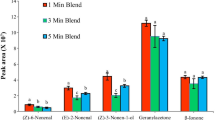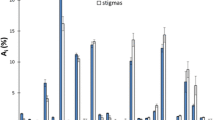Abstract
Traditional fermented shrimp paste is widely recognized for its distinctive flavor, exceptional nutritional value, and numerous health benefits. The volatile components of shrimp paste can be influenced by the production process and geographical environment, thereby reflecting its unique characteristics and quality. The objective of this study was to investigate the correlation between shrimp paste produced from different geographical origins and establish a rapid and accurate method for distinguishing them. To accomplish these objectives, the volatiles of shrimp paste from various regions were extracted using headspace solid-phase micro-extraction (HS-SPME) and subsequently analyzed by GC-MS. The data is pre-processed through (Mass Spectrometry-Data Independent Analysis) MS-DIAL software and then subjected to multivariate statistical analysis, wherein correlation analysis, principal component analysis (PCA), and orthogonal partial least square-discriminant analysis (OPLS-DA) were collectively employed. The findings demonstrate that OPLS-DA exhibits a favorable discriminant region in the context of discriminant analysis. The integration of untargeted GC-MS metabolomics with multivariate statistical analysis offers a rapid and efficient approach for discriminating shrimp paste originating from diverse regions, which circumvents the time-intensive process of volatile compound identification.




Similar content being viewed by others
Data Availability
Data will be made available upon request.
References
Aurum FS, Imaizumi T, Thammawong M, Suhandy D, Zaman MZ, Purwanto E, Praseptiangga D, Nakano K (2023) Predicting Indonesian coffee origins using untargeted SPME-GCMS-based volatile compounds fngerprinting and machine learning approaches. Eur Food Res Technol 249(8):2137–2149
Chan MT, Nor-Khaizura MAR, Mahyudin NA, Jamaludin NS, Khairul NSA, Yahya UII (2021) Antibacterial activity of black cumin, clove, and ginger essential oils against specific spoilage organisms of ready-to-eat chilli shrimp paste. Int Food Res J 28(2):393–400
Chen J, Wang Z, Jia XJ, Li R, Chen JP, Liu XF, Song BB, Zhong SY, Qi Y (2023) Anticoagulant and fibrinolytic properties of two heparinoid compounds prepared from shrimp waste. Foods 12(1):66
Dadalı C (2022) Determination of Prunus mahaleb L.(Mahaleb) Kernel adulteration using volatile compounds combined with chemometrics. Food Anal Method 15(9):2372–2381
Liland KH (2011) Multivariate methods in metabolomics-from pre-processing to dimension reduction and statistical analysis. TRAC-Trend Anal Chem 30(6):827–841
Liu X, Xie J, Zhou L, Zhang J, Chen Z, Xiao J, Cao Y, Xiao H (2022) Recent advances in health benefits and bioavailability of dietary astaxanthin and its isomers. Food Chem 404:134605
Palma J, Pierdominici-Sottile G (2023) On the uses of PCA to characterise molecular dynamics simulations of biological macromolecules: basics and tips for an effective use. Chemphyschem 24(2):e202200491
Sadgrove NJ, Padilla-Gonzalez GF, Phumthum M (2022) Fundamental chemistry of essential oils and volatile organic compounds, methods of analysis and authentication. Plants-Basel 11(6):789
Segade SR, Skrab D, Pezzuto E, Paissoni MA, Giacosa S, Rolle L (2022) Isomer composition of aroma compounds as a promising approach for wine characterization and differentiation: a review. Crit Rev Food Sci Nutr. https://doi.org/10.1080/10408398.2022.2106181
Sripokar P, Klomklao S, Zhang Y, Hansen EB, Maneerat S, Panyo J (2022) Thai traditional fermented fish paste Ka-pi-plaa: chemical compositions and physical properties. J Food Process Pres 46(5):e16610
Su DB, Li KK (2023) Micro Raman spectroscopy combined with chromatographic effect and OPLS-DA for time-resolved detection of stamp inks. Microchem J 190:108727
Sun BK, Wang RY, Li B, Fan X, Zhou Y, Gu B, Yan YY (2022) Rapid identification of polypeptide from carbapenem-resistant and susceptible Escherichia coli via orbitrap-MS and pattern recognition analyses. Chem Biodivers 19(9):e202200118
Tsugawa H, Ikeda K, Takahashi M, Satoh A, Mori Y, Uchino H, Okahashi N, Yamada Y, Tada I, Bonini P, Higashi Y, Okazaki Y, Zhou ZW, Zhu ZJ, Koelmel J, Cajka T, Fiehn O, Saito K, Arita M, Arita M (2020) A lipidome atlas in MS-DIAL 4. Nat Biotechnol 38:1159–1163
Wang M, Chittiboyina AG, Parcher JF, Ali Z, Ford P, Zhao JP, Avula B, Wang YH, Khan IA (2019) Piper nigrum oil-determination of selected terpenes for quality evaluation. Planta Med 85(3):185–194
Warren-Vega WM, Fonseca-Aguinaga R, Gonzalez-Gutierrez LV, Romero-Cano LA (2023) A critical review on the assessment of the quality and authenticity of tequila by different analytical techniques: recent advances and perspectives. Food Chem 408:135223
Williams C, Stander MA, Medvedovici A, Buica A (2023) Volatile terpenoid profiling in gin and beer - a targeted approach. J Food Compos Anal 118:105178
Yang Y, Ferro MD, Cavaco I, Liang Y (2013) Detection and identification of extra virgin olive oil adulteration by GC-MS combined with chemometrics. J Agri Food Chem 61(15):3693–3702
Yue YZ, Liu JW, Shi TT, Chen M, Li Y, Du JH, Jiang HY, Yang XL, Hu HR, Wang LG (2019) Integrating transcriptomic and GC-MS metabolomic analysis to characterize color and aroma formation during tepal development in lycoris longituba. Plants-Basel 8(3):53
Yu J, Lu K, Dong X, Xie W (2022b) Virgibacillus sp. SK37 and Staphylococcus nepalensis JS11 as potential starters to improve taste of shrimp paste. LWT-Food. Sci Technol 154:112657
Yu J, Lu K, Sun J, Xie W, Song L, Che H (2022a) The flavor and antioxidant activity change pattern of shrimp head paste during fermentation. J Ocean U China 21(1):195–203
Yu J, Lu K, Zi J, Yang X, Xie W (2022c) Characterization of aroma profiles and aroma-active compounds in high-salt and low-salt shrimp paste by molecular sensory science. Food Biosci 45:101470
Zhai YL, Guo MY, Meng Q, Song HL (2023) Characterization of key odor-active compounds in high quality high-salt liquid-state soy sauce. J Food Compos Anal 117:105148
Zhao QY, Xi JZ, Xu D, Jin YM, Wu FF, Tong QY, Yin Y, Xu XM (2022) A comparative HS-SPME/GC-MS-based metabolomics approach for discriminating selected japonica rice varieties from different regions of China in raw and cooked form. Food Chem 385:132701
Acknowledgements
The financial support for this work was provided by the Innovation Fund of the Advanced Analysis and Testing Center at Nanjing Forestry University, while additional support was received from the “Analysis and Testing of New Methods and New Research Independent Subject” Program, sponsored by the Jiangsu Scientific Instrument and Equipment Association.
Author information
Authors and Affiliations
Contributions
Xiaoyue Ji: conceptualization, writing – original draft. Wensu Ji: investigation, visualization. Linfei Ding: resources, data curation. All authors reviewed the manuscript.
Corresponding author
Ethics declarations
Conflict of Interest
Xiaoyue Ji declares that she has no conflict of interest. Wensu Ji declares that he has no conflict of interest. Linfei Ding declares that he has no conflict of interest.
Additional information
Publisher’s Note
Springer Nature remains neutral with regard to jurisdictional claims in published maps and institutional affiliations.
Rights and permissions
Springer Nature or its licensor (e.g. a society or other partner) holds exclusive rights to this article under a publishing agreement with the author(s) or other rightsholder(s); author self-archiving of the accepted manuscript version of this article is solely governed by the terms of such publishing agreement and applicable law.
About this article
Cite this article
Ji, X., Ji, W. & Ding, L. Untargeted GC-MS metabolomics combined with multivariate statistical analysis as an effective method for discriminating the geographical origin of shrimp paste. Food Anal. Methods 17, 200–206 (2024). https://doi.org/10.1007/s12161-023-02557-7
Received:
Accepted:
Published:
Issue Date:
DOI: https://doi.org/10.1007/s12161-023-02557-7




